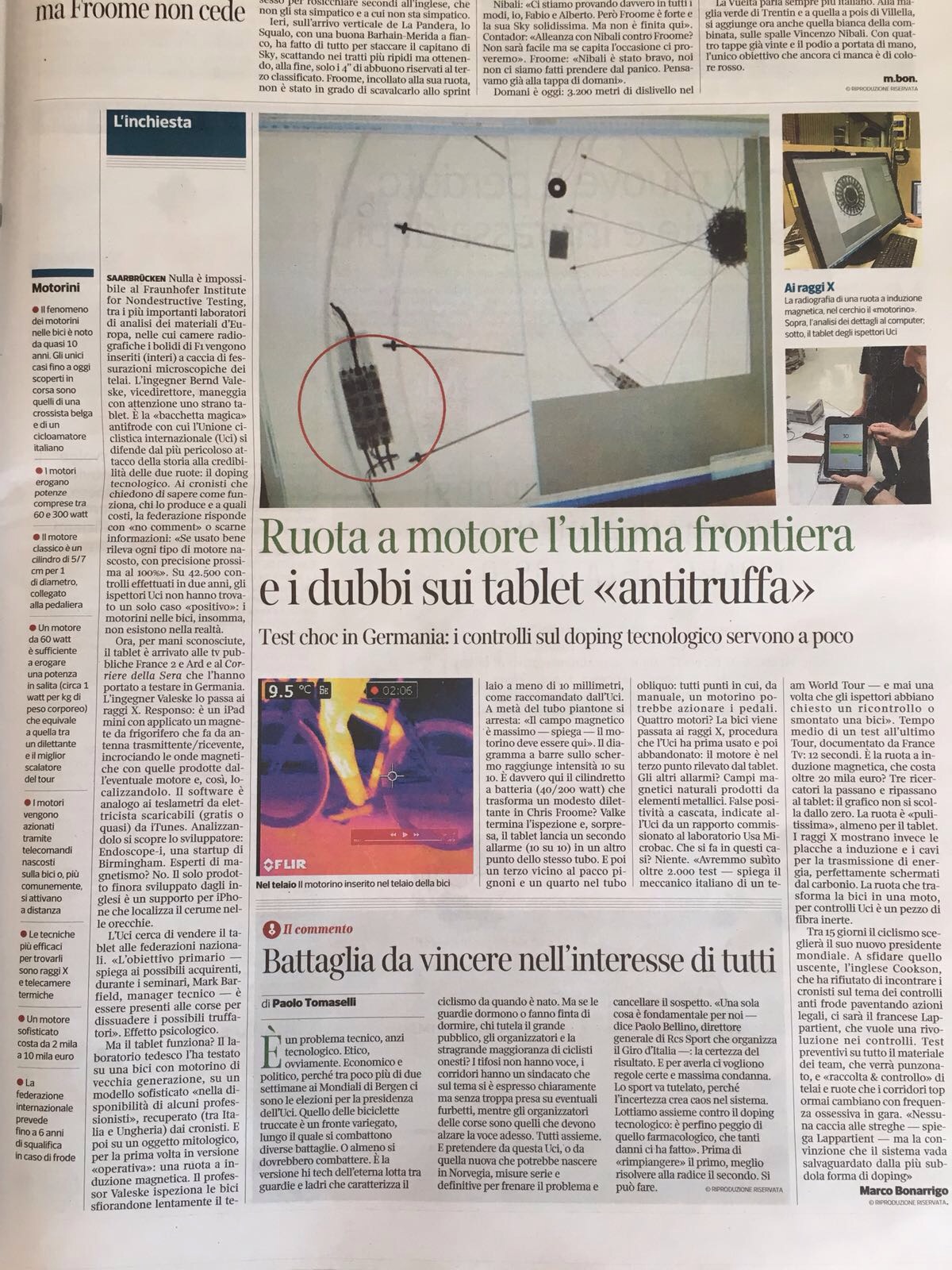UCI's mechanical doping tests called into question - Video
Stade 2 report highlights limitations of tablet devices





The Stade 2 television programme has revealed further details and expressed fresh doubts about the effectiveness of the UCI's tablet device for detecting mechanical doping, revealing that the tablet works on simple ferromagnetic principals, which can often lead to false positives caused by other metallic components of a bicycle, and yet fails to detect the latest form of electro-magnetic mechanical doping hidden in wheels.
Stade 2, working with German television channel ARD and the Italian journalist Marco Bonarrigo, who writes for Il Corriere della Sera, discovered that the tablet device used by the UCI was created by a start-up company based in Britain called Endoscope-i, which was created on the back of iPhone app that works as an endoscope. The company has no experience in cycling.
In the latest investigation, the team of journalists managed to procure one of the UCI tablet devices and had it x-rayed and studied by the Fraunhofer Institute for Non-destructive Testing in Saarbrucken, Germany.
They suggested it is simply an iPad mini with a tiny magnet attached to the blue casing to create a magnetic field. They were surprised to discover that the tablet can only discover ferromagnetic materials, with wheel axles flashing up with the same intensity as a hidden motor in a seat tube. One engineer from the Fraunhofer Institute showed how a simple iPhone app can also detect ferromagnetic materials behind a layer of carbon fibre. The UCI apparently charge national federations several thousand Euro for the tablet device and expert training.
Hungarian engineer Stefano Varjas was again involved in the Stade 2 investigation. He showed off the latest version of his so called 'magic wheel', which does not depend on a hidden motor in the down tube but has a hidden battery in the hub, with the wheel turned by an electro-magnetic booster.
It has been suggested by La Gazzetta dello Sport and others that similar kind of wheels – which cost at least 20,000 Euro – may be have been used in professional races, giving riders a boost in power that can make a significant difference during key moments of races.
Stade 2 started its report by showing images of a number of bike changes during this year's Tour de France, claiming they spark questions despite the UCI never discovering a case of mechanical doping in the professional ranks.
The latest race content, interviews, features, reviews and expert buying guides, direct to your inbox!
The report highlighted that the UCI has carried out 40,000 tests since the introduction of the device in 2016, including 4,000 tests at this year's Tour de France. However, the UCI testers have only rarely insisted on team mechanics taking out the chainset, and only quickly look inside for a hidden motor. The UCI carried out a limited number of x-ray tests during the 2016 Tour de France but have always stood by the validity of their tablet device, even inviting the media to a special presentation in May 2016.
Stade 2, however, suggests that the UCI tablet is unable to detect mechanical doping in wheels.
"If there's a motor that is more or less designed, and specifically if it is less designed, then you can detect it but a smart designed motor is hard to detect," Professor Bernd Valeske of the Fraunhofer Institute told Stade 2 after studying the device.
"Even if these tools [the tablet – ed.] work, the principle itself is not the best way to detect motors. It's a basic tool and a first idea but it's obviously not sufficient. You need a collaboration between different techniques to be sure there are no hidden motors or hidden features."
The UCI refused to give an interview to Stade 2 concerning the latest discoveries but provided information from Microbac Laboratories, a US-based independent testing facility, that claimed the UCI tablet can detect mechanical doping in the downtube under certain conditions, though they confirmed that the device also detected a number of false positives. Data from Microbac suggested that one in three detections of ferromagnetic signals were false positives.
The UCI refused to confirm Endescope-i as the supplier of the tablet device, or give details of the contract between the UCI and the company and explain how Endescope-i was chosen. A UCI statement shown by Stade 2 claimed the company "is specialised in medical applications development offering scanning and research solutions. It's a small one but start-up expert in its field with teams highly qualified in software development, mechanical and electrical engineering and in robotics."
Stade 2 discovered that the company was created around an iPhone attachment that works as a video ear endoscope. Stade 2 travelled to Birmingham to meet the founders and discovered that Endescope-i has no full-time employees or offices. The four partners are two doctors, an engineer and a software developer. Their biggest contract is with the UCI despite not having any previous experience in cycling or magnetic detection systems. Endescope-i refused to answer questions from Stade 2 or fully explain how the tablet works.
